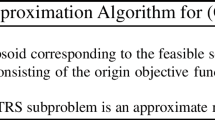Abstract
We give a new polynomial bound on the complexity of approximating the maximal inscribed ellipsoid for a polytope.
Similar content being viewed by others
References
E.R. Barnes, “An algorithm for separating patterns by ellipsoids,”IBM Journal of Research and Development 26 (1982) 759–764.
E.F. Beckenbach and R. Bellman,Inequalities (Springer, Berlin, 1961).
L. Danzer, D. Laugwitz and H. Lenz, “Uber das Lownersche Ellipsoid und sein Analogen unter den einem Eikorper einbeschriebner Ellipsoiden,”Archiv der Mathematik (Basel) 8 (1957) 214–219.
R.M. Freund and J.B. Orlin, “On the complexity of four polyhedral set containment problems,’Mathematical Programming 33 (1985) 139–145.
J.L. Goffin, “Affine and projective transformations in nondifferential optimization,” in: K.H. Hoffmann, J.-B. Hiriart-Urruty, C. Lemarechal and J. Zowe, eds.,Trends in Mathematical Optimization. Proceedings of the 4th French—German Conference on Optimization, Irsee, 1986, ISNM, Vol. 84 (Birkhauser, Basel, 1988) pp. 79–91.
F. John, “Extremum problems with inequalities as subsidiary conditions,” in:Studies and Essays, Courant Anniversary Volume (Interscience, New York, 1948) pp. 187–204.
Ju. E. Nesterov and A.S. Nemirovsky, “Self-concordant functions and polynomial-time methods in convex programming,” USSR Academy of Sciences, Central Economic & Mathematical Institute (Moscow, 1989).
J. Renegar, “A polynomial-time algorithm, based on Newton's method, for linear programming,”Mathematical Programming 40 (1988) 59–93.
G. Sonnevend, “New algorithms in convex programming based on a notion of “centre” (for systems of analytic inequalities) and on rational extrapolation,” in: K.H. Hoffmann, J.-B. Hiriart-Urruty, C. Lemarechal and J. Zowe, eds.,Trends in Mathematical Optimization, Proceedings of the 4th French—German Conference on Optimization, Irsee, 1986, ISNM, Vol. 84 (Birkhauser, Basel, 1988) pp. 311–327.
S.P. Tarasov, L.G. Khachiyan and I.I. Erlikh, “Computing the minimal covering ellipsoid for a system of points, in: O.L. Smirnov, ed.,Methods and Tools for Computer-Aided Design, Vol. 2 (Scientific Council on Cybernetics of the USSR Academy of Sciences, Moscow, 1986) pp. 71–78. [In Russian.]
S.P. Tarasov, L.G. Khachiyan, and I.I. Erlich, “The method of inscribed ellipsoids,”Soviet Mathematics Doklady 37 (1988) 226–230.
D.M. Titterington, “Optimal design: some geometric aspects ofD-optimality,”Biometrica 62 (1975) 313–320.
P.M. Vaidya, “A new algorithm for minimizing a convex function over convex sets,”Proceedings of the 30th Annual FOCS Symposium, Research Triangle Park, NC, 1989 (IEEE Computer Society Press, Los Alamitos, CA, 1990) pp. 338–343.
Y. Ye, “A potential reduction algorithm allowing column generation,”SIAM Journal on Optimization 2 (1992) 7–20.
Author information
Authors and Affiliations
Additional information
Research supported by NSF Grant DMS-8706133.
Research supported by NSF Grant DMS-8904406.
Rights and permissions
About this article
Cite this article
Khachiyan, L.G., Todd, M.J. On the complexity of approximating the maximal inscribed ellipsoid for a polytope. Mathematical Programming 61, 137–159 (1993). https://doi.org/10.1007/BF01582144
Received:
Revised:
Issue Date:
DOI: https://doi.org/10.1007/BF01582144




